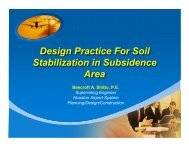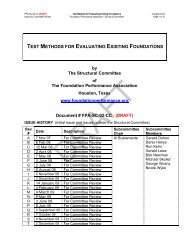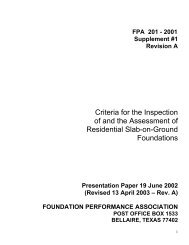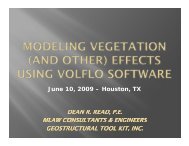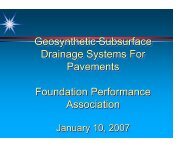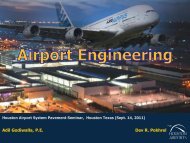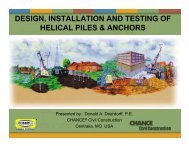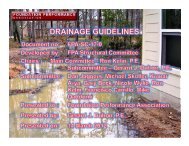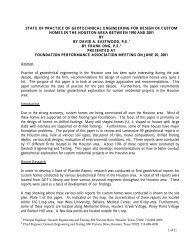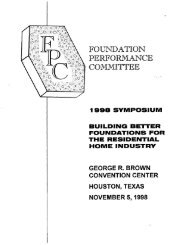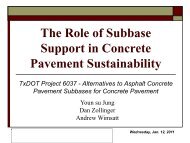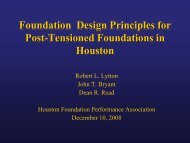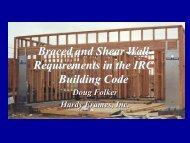Soil-Structure Interaction Seminar - Foundation Performance ...
Soil-Structure Interaction Seminar - Foundation Performance ...
Soil-Structure Interaction Seminar - Foundation Performance ...
You also want an ePaper? Increase the reach of your titles
YUMPU automatically turns print PDFs into web optimized ePapers that Google loves.
<strong>Foundation</strong> Design Considerations<br />
In the areas where highly expansive soils are present, the drilled footings should be founded in<br />
a strong soil stratum below the Active Zone. Active Zone is the zone at which Houston soils<br />
experience shrink and swell movements. This depth is about 10-feet. Therefore, we recommend<br />
a drilled footing depth of about 10- to 11-feet in the areas where the soils stratigraphy and<br />
groundwater depth allow the pier installation. The depth of the active zone should be verified<br />
by a geotechnical exploration. Drilled footings founded at shallower depths may experience<br />
uplift due to expansive soils. In the areas where non-expansive soils are present, the footing<br />
• depth can be as low as eight-feet. Void boxes may be used under the grade beams to separate<br />
the expansive soils from the grade beams.<br />
The grade beams for a floating slab foundation should penetrate clay soils a minimum of 12inches.<br />
The grade beam penetrations for a floating slab foundation into the surficial sands should<br />
be at least 18-inches to develop the required bearing capacity. A minimum grade beam width<br />
of 12-inches is recommended in sands and silts.<br />
In the event that a floating slab (post-tensioned slab or a conventionally-reinforced slab) is<br />
constructed in sands or silts, the geotechnical engineer must specify bearing capacity, assuming<br />
saturated subsoil conditions. This results in bearing capacities in the range of 600- to 900 psf<br />
in a typical sand or silt soils in the Houston area. Higher bearing capacity values can be used<br />
if the sands/silts do not get saturated during the life of the residence. This assumption is<br />
generally unrealistic due to the presence of sprinkler systems, negative drainage, and cyclic<br />
rainfall in the Houston area.<br />
Design parameters for a post-tensioned slab on expansive clays must carefully evaluated by a<br />
geotechnical engineer. It should be noted that the current post-tensioned slab design manual does<br />
not properly model the poor drainage, the effect of the trees, and the depth of the active zone.<br />
Revisions to the post-tensioned slab manual is under way to correct some of the short comings.<br />
In the mean time, the designer must use experience and judgment when designing post-tensioned<br />
slabs. The following design parameters are recommended for design of a post-tensioned slab<br />
in the Houston area in parts of the city with highly expansive soils (plasticity indices greater than<br />
40):<br />
Edge Moisture Variation, em, feet<br />
Edge Lift<br />
Center Lift<br />
Differential Swell Ym, inches<br />
Edge Lift<br />
Center Lift<br />
5.5<br />
4.5<br />
0.9<br />
1.0<br />
GEOTECH ENGINEERING AND TESTING, INC. ____________ _.<br />
12



